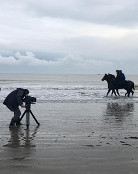Donn's Articles » Ballydoyle Derbies
Ballydoyle Derbies
When Aidan O’Brien sent out Cape Blanco to win the Dubai Duty Free Irish Derby on Sunday, he sent the record-book writers scurrying in search of the quill again.
It was the eighth time that O’Brien had won the Irish Derby, the seventh time in the last 10 years and the fifth time in a row. No other trainer has ever won an Irish Classic five times in a row.
Aidan O’Brien and broken records are not newly acquainted bedfellows. On the contrary, they are old pals. It was his ability to break records with ordinary horses (first three home in the Galway Plate, fastest ton in a calendar year, most winners in a week) that earned him the job at Ballydoyle in the first place. However, for one trainer to dominate the premier Irish Classic to the extent that he has in the last decade is truly remarkable.
As well as sending out Cape Blanco to win Sunday’s race, O’Brien also sent out Midas Touch and Jan Vermeer to follow him home. It was the second time in the last four renewals of the race, and the third time in the last nine, that the first three horses home in the Irish Derby had been trained by Aidan O’Brien. More than that, the first, second and fourth in the race last year were trained by the master of Ballydoyle, as were the winner and the third in 2008. That means that, of the 12 places that were up for grabs in the Irish Derby in the last four years, 10 of them have been filled by horses that were prepared for the race by Aidan O’Brien. It is an astonishing record.
It is difficult to know why success in the Epsom Derby hasn’t flowed so fruitfully. King Of Kings provided O’Brien with his first British Classic when he won the 2000 Guineas in 1998, a year after Classic Park and Desert King had provided him with his first Irish Classics, but he had to wait another four years before he cracked the Epsom Derby.
He didn’t have a runner in the race in 1997, but he ran three in 1998, Saratoga Springs and Second Empire as well as King Of Kings. Saffron Walden was his sole representative in 1999, while Aristotle flew the flag in 2000, yet all of them came up a fair way short. Then Galileo hit the bullseye in 2001.
Galileo’s win was huge. Not only was he O’Brien’s first, he was also the first Derby winner who was owned by Sue Magnier and Michael Tabor, he was Ballydoyle’s first since Golden Fleece almost 20 years earlier, and he was Sadler’s Wells’s first, giving a sense of completion to the CV of the most influential stallion of the modern age. Then High Chaparral came along the following year and provided a second for all.
There were three Ballydoyle representatives in the Epsom Derby that year, and two of them, High Chaparral and Hawk Wing, dominated the market and the race. They had the race to themselves for the length of the home straight, and they finished 12 lengths clear of their rivals. As a sign of strength and superiority, it was immense; as an indication of things to come, it was ominous.
It is a little incongruous, then, that Team Ballydoyle haven’t won the Epsom Derby since. Various theories have been advanced as to why that is. Perhaps the race comes up so early in the season that it doesn’t fit in with the Ballydoyle slow-burn policy. Or perhaps the typical Ballydoyle horse tends to suit The Curragh more than Epsom. Because of their respective configurations, Epsom demands more speed than The Curragh, where stamina and courage rule, and the ability to maintain a gallop is more important than any other talent.
One possible reason that hasn’t been widely proposed: happenstance. Bad luck. The Derby comes around just once a year, you get one shot at winning it every 12 months, it doesn’t happen for you one day, the next day you don’t have the right horse, and suddenly people are talking in terms of years. It’s a bit like JP McManus and the Grand National: why hadn’t he won it before this year? Because it’s not easy, that’s why.
And Aidan O’Brien has gone mighty close on numerous occasions in the last few years. In 2003, he sent out The Great Gatsby to finish second to Kris Kin. In 2006, Dylan Thomas was beaten a short head and a head. In 2007 Eagle Mountain was second to Authorized. Last year, Ballydoyle would have had the first four home in the Derby were it not for the presence of the once-in-a-generation superstar that was Sea The Stars. This year, At First Sight finished second to Workforce, and three of the first five home were Ballydoyle horses. If the ball had hopped differently, if everything had gone in his favour, it is only stretching it a little to say that O’Brien could have trained five of the last eight Epsom Derby winners instead of none.
If you continue to pepper the target, sooner or later you are sure to hit the bullseye again.
© The Racing Post, 29th June 2010


 Follow Donn
Follow Donn